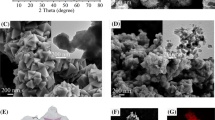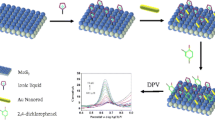Abstract
An electrochemical sensor for the carcinogen 4,4′-oxydianiline (Oxy) is described. The method is based on the ability of MoS2 nanosheets to preconcentrate Oxy. A glassy carbon electrode (GCE) was covered, by drop-casting, with MoS2 nanosheets that were obtained by exfoliation. X-Ray photoemission spectroscopy indicates that Oxy accumulates on the MoS2 nanosheets through an electropolymerization process similar to that reported for aniline. Both electrochemical impedance spectroscopy and atomic force microscopy were used to characterize the electrode surface at the different stages of device fabrication. Employing the current measured at +0.27 V vs. Ag/AgCl after Oxy adsorption, the modified GCE enables the voltammetric detection of Oxy at 80 nM levels with relative errors and relative standard deviations of <8.3 and <5.6%, respectively, at all the concentrations studied. The method was applied to the selective determination of Oxy in spiked river water samples. Very good selectivity and recoveries of around 95% in average are found.

Schematic representation of 4,4-oxydianiline electrochemical polymerization and preconcentration onto molybdenum disulfide nanosheets for the diamine determination in river waters.




Similar content being viewed by others
References
Vilian ATE, Dinesh B, Kang SM, Krishnan UM, Huh YS, Han YK (2019) Recent advances in molybdenum disulfide-based electrode materials for electroanalytical applications. Microchim Acta 186:203. https://doi.org/10.1007/s00604-019-3287-y
Mas-Ballesté R, Gómez-Navarro C, Gómez-Herrero J, Zamora F (2011) 2D materials: to graphene and beyond. Nanoscale 3:20–30. https://doi.org/10.1039/C0NR00323A
Gupta A, Sakthivel T, Seal S (2015) Recent development in 2D materials beyond graphene. Prog Mater Sci 73:44–126. https://doi.org/10.1016/j.pmatsci.2015.02.002
Sinha A, Dhanjai TB, Huang Y, Zhao H, Dang X, Chen J, Jain R (2018) MoS2 nanostructures for electrochemical sensing of multidisciplinary targets: a review. TrAC Trends Anal Chem 102:75–90. https://doi.org/10.1016/j.trac.2018.01.008
Sun J, Li X, Guo W, Zhao M, Fan X, Dong Y, Xu C, Deng J, Fu Y (2017) Synthesis methods of two-dimensional MoS2: a brief review. Crystals 7:198. https://doi.org/10.3390/cryst7070198
Kumar R, Kulriya PK, Mishra M, Singh F, Gupta G, Kumar M (2018) Highly selective and reversible NO2 gas sensor using vertically aligned MoS2 flake networks. Nanotechnology 29:464001. https://doi.org/10.1088/1361-6528/aade20
Coleman JN, Lotya M, O’Neill A et al (2011) Two-dimensional nanosheets produced by liquid exfoliation of layered materials. Science 331:568–571. https://doi.org/10.1126/science.1194975
Nicolosi V, Chhowalla M, Kanatzidis MG, Strano MS, Coleman JN (2013) Liquid exfoliation of layered materials. Science 340:72–75. https://doi.org/10.1126/science.1226419
Fan X, Xu P, Zhou D, Sun Y, Li YC, Nguyen MAT, Terrones M, Mallouk TE (2015) Fast and efficient preparation of exfoliated 2H MoS2 nanosheets by sonication-assisted lithium intercalation and infrared laser-induced 1T to 2H phase reversion. Nano Lett 15:5956–5960. https://doi.org/10.1021/acs.nanolett.5b02091
Kirubasankar B, Palanisamy P, Arunachalam S, Murugadoss V, Angaiah S (2019) 2D MoSe2-Ni(OH)2 nanohybrid as an efficient electrode material with high rate capability for asymmetric supercapacitor applications. Chem Eng J 355:881–890. https://doi.org/10.1016/j.cej.2018.08.185
Seman RNAR, Azam MA, Ani MH (2018) Graphene/transition metal dichalcogenides hybrid supercapacitor electrode: status, challenges, and perspectives. Nanotechnology 29:502001
Xu G, Yang L, Wei X, Ding J, Zhong J, Chu PK (2016) MoS2-quantum-dot-interspersed Li4Ti5O12 nanosheets with enhanced performance for Li- and Na-Ion batteries. Adv Funct Mater 26:3349–3358. https://doi.org/10.1002/adfm.201505435
Ma L, Zhou X, Xu L, Xu X, Zhang L, Chen W (2015) Chitosan-assisted fabrication of ultrathin MoS2/graphene heterostructures for Li-ion battery with excellent electrochemical performance. Electrochim Acta 167:39–47. https://doi.org/10.1016/j.electacta.2015.03.129
Huang J, Dong Z, Li Y, Li J, Tang W, Yang H, Wang J, Bao Y, Jin J, Li R (2013) MoS2 nanosheet functionalized with Cu nanoparticles and its application for glucose detection. Mater Res Bull 48:4544–4547. https://doi.org/10.1016/j.materresbull.2013.07.060
Song D, Wang Y, Lu X, Gao Y, Li Y, Gao F (2018) Ag nanoparticles-decorated nitrogen-fluorine co-doped monolayer MoS2 nanosheet for highly sensitive electrochemical sensing of organophosphorus pesticides. Sensors Actuators B Chem 267:5–13. https://doi.org/10.1016/j.snb.2018.04.016
Su S, Sun H, Xu F, Yuwen L, Wang L (2013) Highly sensitive and selective determination of dopamine in the presence of ascorbic acid using gold nanoparticles-decorated MoS2 nanosheets modified electrode. Electroanalysis 25:2523–2529. https://doi.org/10.1002/elan.201300332
Zhou J, Zhao Y, Bao J, Huo D, Fa H, Shen X, Hou C (2017) One-step electrodeposition of Au-Pt bimetallic nanoparticles on MoS2 nanoflowers for hydrogen peroxide enzyme-free electrochemical sensor. Electrochim Acta 250:152–158. https://doi.org/10.1016/j.electacta.2017.08.044
Lin Y, Chen X, Lin Y, Zhou Q, Tang D (2015) Non-enzymatic sensing of hydrogen peroxide using a glassy carbon electrode modified with a nanocomposite made from carbon nanotubes and molybdenum disulfide. Microchim Acta 182:1803–1809. https://doi.org/10.1007/s00604-015-1517-5
Saraf M, Natarajan K, Saini AK, Mobin SM (2017) Small biomolecule sensors based on an innovative MoS2–rGO heterostructure modified electrode platform: a binder-free approach. Dalton Trans 46:15848–15858. https://doi.org/10.1039/c7dt03888g
Aksimsek S, Jussila H, Sun Z (2018) Graphene–MoS2–metal hybrid structures for plasmonic biosensors. Opt Commun 428:233–239. https://doi.org/10.1016/j.optcom.2018.07.075
Sajedi-Moghaddam A, Saievar-Iranizad E, Pumera M (2017) Two-dimensional transition metal dichalcogenide/conducting polymer composites: synthesis and applications. Nanoscale 9(24):8052–8065. https://doi.org/10.1039/C7NR02022H
Huang KJ, Liu YJ, Wang HB, Wang YY, Liu YM (2014) Sub-femtomolar DNA detection based on layered molybdenum disulfide/multi-walled carbon nanotube composites, au nanoparticle and enzyme multiple signal amplification. Biosens Bioelectron 55:195–202. https://doi.org/10.1016/j.bios.2013.11.061
Vijayaraj K, Dinakaran T, Lee Y, Kim S, Kim HS, Lee J, Chang SC (2017) One-step construction of a molybdenum disulfide/multi-walled carbon nanotubes/polypyrrole nanocomposite biosensor for the ex-vivo detection of dopamine in mouse brain tissue. Biochem Biophys Res Commun 494:181–187. https://doi.org/10.1016/j.bbrc.2017.10.059
Petit-Domínguez MD, Quintana C, Vázquez L, del Pozo M, Cuadrado I, Parra-Alfambra AM, Casero E (2018) Synergistic effect of MoS2 and diamond nanoparticles in electrochemical sensors: determination of the anticonvulsant drug valproic acid. Microchim Acta 185:334. https://doi.org/10.1007/s00604-018-2793-7
Parra-Alfambra AM, Casero E, Vázquez L, Quintana C, del Pozo M, Petit-Domínguez MD (2018) MoS2 nanosheets for improving analytical performance of lactate biosensors. Sensors Actuators B Chem 274:310–317. https://doi.org/10.1016/j.snb.2018.07.124
Ma L, Wang G, Dai J (2017) Preparation of a functional reduced graphene oxide and carbon nanotube hybrid and its reinforcement effects on the properties of polyimide composites. J Appl Polym Sci 134:1–9. https://doi.org/10.1002/app.44575
Khan F, Kausar A, Siddiq M (2016) Buckypapers of 4,4′-oxydianiline-modified polyvinylchloride and functional nano-filler obtained by resin infusion method. Iran Polym J 25:213–228. https://doi.org/10.1007/s13726-016-0415-y
International Agency for Research on Cancer (1987) IARC monographs on the evaluation of the carcinogenic risks to humans
Andreescu D, Sadik OA (2005) Synthesis of polyoxydianiline membranes onto gold electrodes. J Electrochem Soc 152:E299–E307. https://doi.org/10.1149/1.2001427
Chang WY, Sung YH, Da Huang S (2003) Analysis of carcinogenic aromatic amines in water samples by solid-phase microextraction coupled with high-performance liquid chromatography. Anal Chim Acta 495:109–122. https://doi.org/10.1016/j.aca.2003.08.021
Lizier TM, Zanoni MVB (2012) Effect of ionic liquid on the determination of aromatic amines as contaminants in hair dyes by liquid chromatography coupled to electrochemical detection. Molecules 17:7961–7979. https://doi.org/10.3390/molecules17077961
Mortensen SK, Trier XT, Foverskov A, Petersen JH (2005) Specific determination of 20 primary aromatic amines in aqueous food simulants by liquid chromatography-electrospray ionization-tandem mass spectrometry. J Chromatogr A 1091:40–50. https://doi.org/10.1016/j.chroma.2005.07.026
Garrigós MC, Reche F, Marín ML, Jiménez A (2002) Determination of aromatic amines formed from azo colorants in toy products. J Chromatogr A 976:309–317. https://doi.org/10.1016/S0021-9673(02)01162-7
Domínguez CSH, Quintana C, Vicente J, Hernández P, Hernández L (2008) Sub-monolayer assemblies of octanethiol and octadecylthiol at gold electrodes for the direct analysis of 4,4′-oxydianiline in wastewaters and shoe-dyeing samples. Talanta 74:1014–1019. https://doi.org/10.1016/j.talanta.2007.08.006
Domínguez CSH, Quintana MC, Hernández P (2013) Self-assembled monolayers of cucurbit[6]uril on a gold electrode for 4,4’-Oxydianiline determination. Analytical application. Electroanalysis 25(5):1217–1222. https://doi.org/10.1002/elan.201200669
Shim Y, Won M-S, Park S (1990) Electrochemistry of conductive polymers VIII. In situ spectroelectrochemical studies of polyoniline growth mechanisms. J Electrochem Soc 137:538–544
Huang SX, Fischer DA, Gland JL (1996) Aniline adsorption, hydrogenation, and hydrogenolysis on the Ni(100) surface. J Phys Chem 3654:10223–10234. https://doi.org/10.1021/jp951868s
Olivares O, Likhanova NV, Gómez B, Navarrete J, Llanos-Serrano ME, Arce E, Hallen JM (2006) Electrochemical and XPS studies of decylamides of α-amino acids adsorption on carbon steel in acidic environment. Appl Surf Sci 252:2894–2909. https://doi.org/10.1016/j.apsusc.2005.04.040
Jordan JL, Kovac CA, Morar JF, Pollak RA (1987) High-resolution photoemission study of the interfacial reaction of Cr with polyimide and model polymers. Phys Rev B 36:1369–1377
Senanayake SD, Liu Z (2016) Ambient pressure XPS and IRRAS investigation of ethanol steam reforming on Ni–CeO2(111) catalysts: an in situ study of C–C and O–H bond scission. Phys Chem Chem Phys 18:16621–17118. https://doi.org/10.1039/c6cp01212d
Abel M, Rattana A, Watts JF (2000) Interaction of epoxy analogue molecules with organosilane-treated aluminum : a study by XPS and ToF – SIMS. Langmuir 16:6510–6518. https://doi.org/10.1021/la9915724
Ruiz del Árbol N, Palacio I, Otero-irurueta G, Martínez JI, de Andrés PL, Stetsovych O, Moro-Lagares M, Mutombo P, Svec M, Jelínek P, Cossaro A, Floreano L, Ellis GJ, López MF, Martín-Gago JA (2018) On-surface bottom-up synthesis of azine derivatives displaying strong acceptor behavior. Angew Chem Int Ed 57:1–6. https://doi.org/10.1002/anie.201804110
Chan HSO, Ng SC, Sim WS, Tan KL, Tan BTG (1992) Preparation and characterization of electrically conducting copolymers of aniline and anthranilic acid: evidence for self-doping by X-ray photoelectron spectroscopy. Macromolecules 25:6029–6034
Chen Y, Kang ET, Neoh KG, Lim SL, Ma ZH, Tan KL (2001) Intrinsic redox states of polyaniline studied by high-resolution X-ray photoelectron spectroscopy. Colloid Polym Sci 76:73–76
Schubert J, Kappenstein O, Luch A, Schulz TG (2011) Analysis of primary aromatic amines in the mainstream waterpipe smoke using liquid chromatography-electrospray ionization tandem mass spectrometry. J Chromatogr A 1218:5628–5637. https://doi.org/10.1016/j.chroma.2011.06.072
Perez MÁF, Padula M, Moitinho D, Bottoli CBG (2019) Primary aromatic amines in kitchenware: determination by liquid chromatography-tandem mass spectrometry. J Chromatogr A 1602:217–227. https://doi.org/10.1016/j.chroma.2019.05.019
Jeyapragasam T, Meena Devi J, Ganesh V (2018) Molybdenum disulfide-based modifier for electrochemical detection of 4-nitrophenol. Ionics (Kiel) 24:4033–4041
Gan X, Zhao H, Wong K, Yuan D, Zhang Y, Quan X (2018) Covalent functionalization of MoS2 nanosheets synthesized by liquid phase exfoliation to construct electrochemical sensors for Cd (II) detection. Talanta 182:38–48. https://doi.org/10.1016/j.talanta.2018.01.059
Acknowledgements
The authors acknowledge financial support from the Spanish MICINN (MAT2017-85089-C2-1-R, MAT2017-85089-C2-2-R) and the EU via the ERC-Synergy Program (grant ERC-2013-SYG-610256 NANOCOSMOS) and Horizon 2020 Research and Innovation Program (Graphene Flagship-core2 - 785219) and the Comunidad Autónoma de Madrid (P2018/NMT-4349, TRANSNANOAVANSENS-CM and P2018/NMT-4367 FOTOART).
Author information
Authors and Affiliations
Corresponding author
Additional information
Publisher’s note
Springer Nature remains neutral with regard to jurisdictional claims in published maps and institutional affiliations.
Electronic supplementary material
ESM 1
(DOCX 1531 kb)
Rights and permissions
About this article
Cite this article
del Pozo, M., Sánchez-Sánchez, C., Vázquez, L. et al. Differential pulse voltammetric determination of the carcinogenic diamine 4,4′-oxydianiline by electrochemical preconcentration on a MoS2 based sensor. Microchim Acta 186, 793 (2019). https://doi.org/10.1007/s00604-019-3906-7
Received:
Accepted:
Published:
DOI: https://doi.org/10.1007/s00604-019-3906-7




